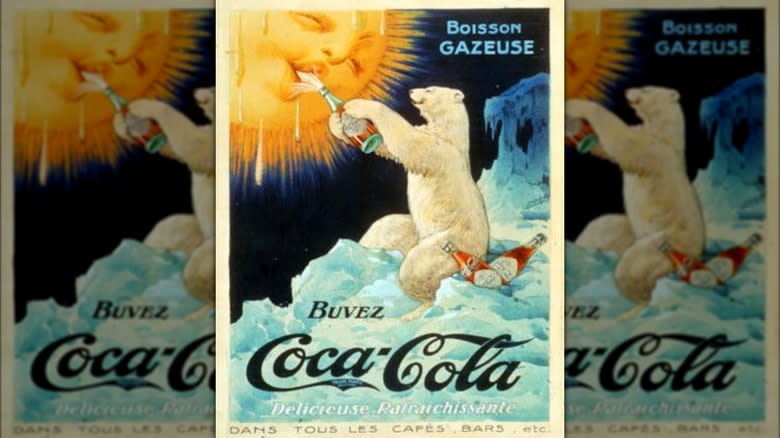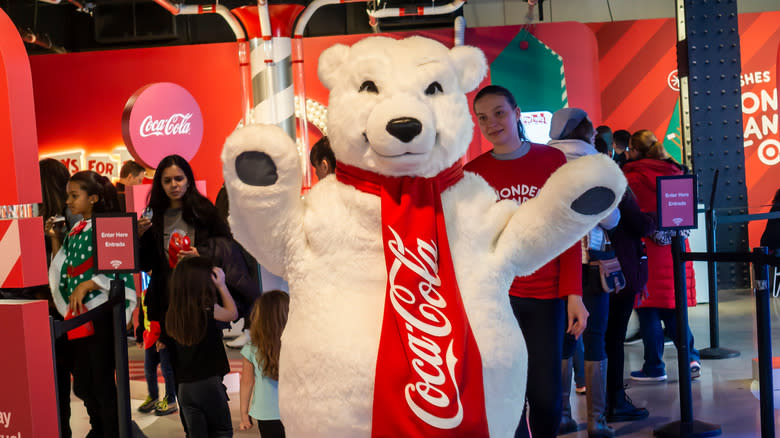The History Of Coca-Cola’s Iconic Polar Bear Mascots, Explained
For decades, Coca-Cola has used polar bears to advertise and market one of the most popular soda brands in the world. Whether images of the Arctic animal are featured on packaging or star in television commercials, polar bears are strongly linked to the Coca-Cola brand. Although first seen in 1922, the Coca-Cola bear as we know it today is due to a reimagined campaign by a talented artist that debuted in 1993.
Those Coke polar bears have popped up to sell soda (and drink it themselves) in dozens of commercials, and they’re the only major mascot in the soft drink company’s long and storied history (unless you count Santa Claus, who has been featured in Coke ads since the ’30s). From origins in European print advertisements, to animated characters starring in Super Bowl ads, to the inspiration for plenty of merchandise, here’s a look back at the development, evolution, and importance of the Coca-Cola polar bear mascot.
Read more: The 14 Best Sugar-Free Sodas Ranked
Polar Bears First Popped Up In Coca-Cola Ads In The 1920s

Made from one of the world’s most closely guarded recipes, Coca-Cola was first sold in France in 1919, and three years later, local distributors created a print advertisement for the beverage, imploring consumers to buvez (or, in English, “drink”) Coca-Cola. The art strongly conveyed how refreshing Coke could be by placing it in the hands of a polar bear. According to Cardiff University’s blog on Arctic Relations, this coincides with a time when “polar bear imagery was thriving in fine art, popular culture, and entertainment,” in Europe. In Germany, there was a polar bear “craze” where people in polar bear costumes would often pose in public for photographs.
Over the next seven decades, Coca-Cola print marketing campaigns made use of polar bear imagery here and there. But the company never fully embraced the cold-dwelling animal as an advertising mascot until 1993, when the animal starred in a TV commercial. To devise a visually striking campaign for Creative Artists Agency, artist Ken Stewart thought about how he drank Coke while watching movies, and then got a glimpse of his Labrador retriever, who he says resembled a polar bear at the puppy stage. Stewart put those two ideas together, and decided that a movie for Coke-drinking polar bears in the Arctic wilderness would be the Northern Lights. “Northern Lights” became the name of that Coca-Cola spot, the first of more than two dozen animated commercials starring the animals.
The Polar Bear Mascot Still Shows Up Plenty Of Places


The bears still appear in the occasional Coca-Cola commercial, while enjoying status as a beloved corporate mascot. Visitors to Atlanta’s World of Coca-Cola, one of the world’s tastiest food museums, can have their photo taken with a costumed employee. The bear also makes frequent public appearances around the country. Each winter holiday period, artistic renderings of the growing Coca-Cola polar bear family appear on packaging and cans of Coke products, and merchandise is sold on the company website. In 2013, the second generation of the characters starred in a seven-minute short film called “The Polar Bears,” directed by Academy Award-winner Ridley Scott.
In 2008, polar bears qualified for protection under the Endangered Species Act. Along with increased public consciousness of melting sea ice, polar bears became strongly associated with climate change. That could have threatened Coca-Cola’s use of the animal as a cute mascot. “The further the character gets away from being a real character in the world, the less a company needs to worry about what happens in the real world,” University of Saskatchewan marketing professor Barbara Phillips told the New Yorker. To help save the polar bears, Coca-Cola pledged a $2 million donation to the World Wildlife Fund in 2011, and collected $3 million more from consumers. These moves were announced in a 2013 Coca-Cola ad that starred real polar bears.
Read the original article on The Daily Meal.
